Parts to a Roof: Terms You Need to Know When Talking to a Roofer
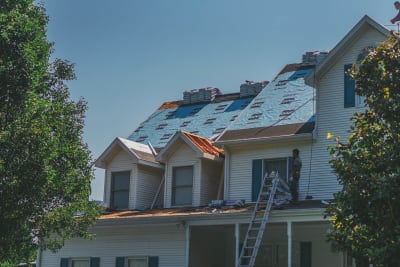
Knowing how to identify all the different parts to a roof will help you feel more comfortable when talking with your roofer. It’s also helpful to know the anatomy of your roof — how those parts fit together.
Each layer and component has a purpose. And they all work together to make sure your roof provides maximum protection.
The roofing industry has a specific vocabulary as well. Understanding that vocabulary is key to communicating clearly with your roofer. It means you and your roofer are more likely to stay on the same page during your roofing replacement or repair.
Study this labeled cross-section of a roof. Keep this roofing glossary handy. Be a well-informed homeowner, and you’ll be better prepared to see that your roofing project meets your expectations and lasts for years to come.

Parts to a Roof & Terms You Need to Know
Architectural Shingle
Architectural asphalt shingles are among the highest quality asphalt shingles available. They have multiple layers of tabs to add thickness, dimension, performance, and durability to a roof.
Architectural shingles are also referred to as three-dimensional or laminated shingles. By contrast, three-tab shingles are made of a single layer of tabs and appear flat or without the dimension of a laminated shingle.
They are designed to be more aesthetic, with the most common styles resembling wood shake shingles. Architectural shingles are available in multiple colors and styles and usually come with longer warranties since some can last up to 50 years.
Asphalt Shingle
Asphalt shingles are the most popular roofing shingle because of its cost. They can be made of an organic, asphalt-saturated or fiberglass base with one or both sides covered with asphalt or modified asphalt to provide a waterproofing quality. The top surface is then infused with reflective material such as slate, quartz, stone, or ceramic granules, which block ultraviolet light.
Battens
Roof battens, or furring strips, are thin strips of wood, plastic or metal that are used to provide a fastening point for the roofing material. They are most often used with clay, stone, or concrete tiles.
Cool Roof
Any roof that is designed to reflect more sunlight and absorb less heat than a standard roof is called a “cool roof.” Cool roofs are optimized with coatings, light reflective colors, or high solar reflectance to be energy efficient.
Course
Each row of shingles or roofing material is equal to one course.
Decking
Roof decking, or sheathing, is the strong layer of wood that is laid on top of the rafters and becomes the base layer for any roof covering. Decks are most often made of plywood sheets or stand board (OSB).
Dormer
A window that projects from a sloping roof. Derived from the latin word “dormitorium,” for sleeping room. Dormers are often used in bedrooms under a sloped roof to add windows to the space.

Downspout
A downspout is a pipe, usually at the corners of the roof, that carries water from the gutters to the ground level. Gutters attached to the eaves of the roof carry water to the downspout which directs water to the ground or to a drain at ground level.
Drip Edge
Metal flashing used at the edges of the roof designed to control the direction of dripping water is called a drip edge. They are designed with a lip or bent edge to break the surface tension of water to prevent it from flowing back under the shingles.
Eaves
The eaves are the edges of the roof that hang over or beyond the vertical walls of a building. Their main purpose is to direct water away from the building itself. Eaves can have decorative or architectural elements!
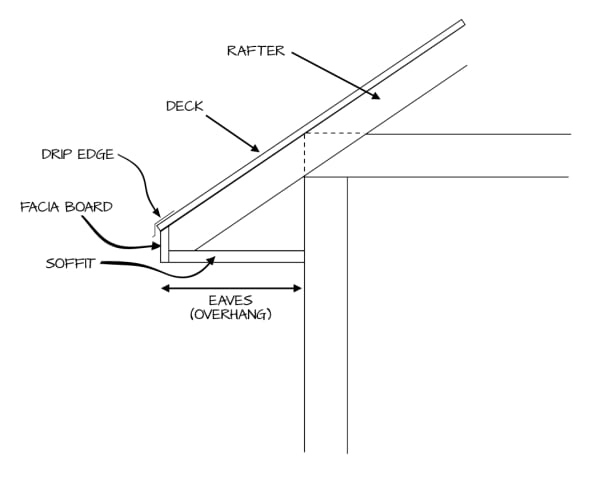
Energy-Efficient Roof
An energy-efficient roof is any roof that is designed to reflect more sunlight and absorb less heat than a standard roof. Energy Star Ratings identify a roofing material’s ability to reflect solar radiation and emit absorbed heat. (See “Cool Roofs.”)
Felt
Roofing felt refers to a type of tar paper made from glass fibre or polyester fleece infused with bituminous material. Produced in roll form, roofing felt and tar paper are most commonly used as an underlayment for roofing and siding materials.
Fire Resistance
Fire resistance is rated by a material’s ability to withstand exposure to fire originating from sources outside the building.
- Class “A” Fire Resistance: The highest fire test classification for roofing as per ASTM E108 or UL790. Rated to withstand severe exposure to fire originating from sources outside the building.
- Class “B” Fire Resistance: Rated as being capable of withstanding moderate exposure to fire originating from sources outside the building.
- Class “C” Fire Resistance: Indicates an ability to withstand light exposure to fire originating from sources outside the building.
Flashing
Flashing is a thin material, usually galvanized steel, used to direct water away from critical areas of the roof. It adds protection from water penetration in the valleys, in areas where the roof plane meets a vertical surface (e.g. at a wall, chimney or dormer), and around other roof features such as vents and skylights or edges.
Flat-roof Membrane
Membrane roofing is a watertight roof covering to protect the interior of a building. Most commonly made from synthetic rubber, thermoplastic (PVC or similar material), or modified bitumen. Membrane roofs are most commonly used for flat roofs and in commercial applications.
Gable
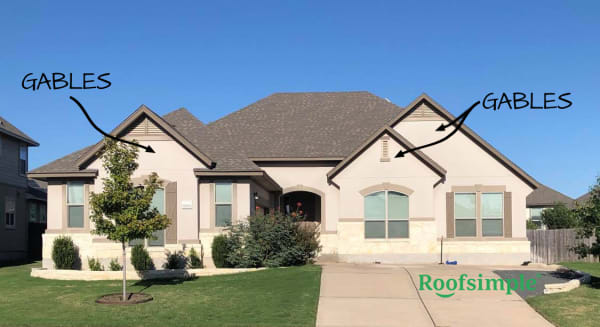
A gable is the triangular part of a wall between intersecting roof pitches that encloses the end of a pitched roof. The shape of the gable and how it is detailed depends on the type of roof structure used
Granules
Graded particles of crushed rock, slate, slag, porcelain, or tile used as surfacing on asphalt roofing and shingles. Granules provide protection from UV rays that can cause the degradation of shingles. They also add to the durability of the shingles in transport and after installation.
Granules tend to shed as they age — the adhesive sealant begins to lose its adhesion or wind and weather loosens them. When bare spots or shiny spots appear on shingles, it may indicate that the shingles, or the entire roof, need to be replaced.
Green Roof
A green roof is often referred to as a living roof because the roof of the building is partially or completely covered with vegetation and a growing medium. They may include several special layers such as a waterproofing membrane, a root barrier, filter cloth, drainage and irrigation systems.
Green roofs are also considered “Cool Roofs” because they significantly lower utility bills and the ambient temperature of the roof.
Gutters
Gutters are pipes or shallow troughs attached to the edge of a roof for carrying rainwater away from the building.
Hip
The point where two slopes meet and run to the eave is called the hip.
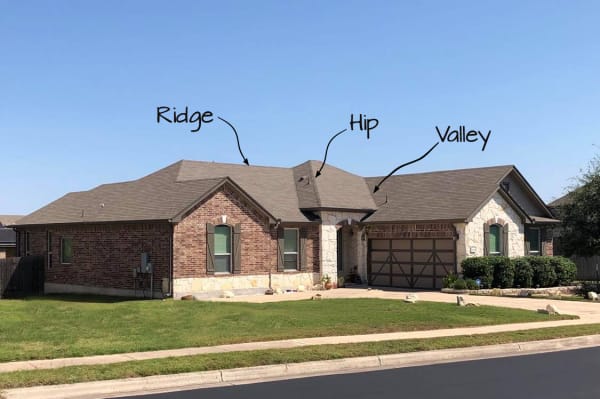
Hip Shingles
Hip shingles, or ridge cap shingles, are a single layer shingle used to cover the inclined angle formed by the hip or intersection of two slopes of roof. Some manufacturers do produce double layered shingles and even shingles that are folded to create superior strength and design.
Ice and Water Barrier
An ice and water shield is a fully-adhered roof underlayment with an adhesive back used to prevent damage caused by ice dams and wind driven rain. It is usually installed all along the edge of the roof, in any valleys, vent pipes, or any other structure or wall that connects with or penetrates the roof.
Ice Dam
An ice dam refers to ice build-up on the eaves of sloped roofs of heated buildings. It results from melting snow under a snow pack reaching the eave and refreezing there. When an ice dam forms, additional melting snow runs to the eaves and is prevented from flowing off the roof. That water is then forced back up the roof and under the shingles, increasing the possibility of leaks.
Impact Resistance
Impact Resistance is the resistance classification given to roofing material per the Underwriter Laboratories (UL) 2218 Impact test. This rating indicates which shingles are more resistant to impacts resulting from hail storms.
A shingle receiving a Class 4 rating can withstand the impact from a 2 inch steel ball dropped twice from 20 feet with no evidence of cracking or tearing. A Class 3 rating, by contrast, would only be able to withstand the impact of a 1.75 inch steel ball.

Laminated Shingles
(See: Architectural Shingle)
Moisture Barrier
Moisture barriers are building materials designed to prevent water from getting past the barrier. As a roofing underlayment, the moisture barrier is installed over the deck of the roof and under all the other layers of the roof.
Overhang
(See: Eaves)
Rafters
Rafters are the internal beams that extend from the eaves to the peak of a roof and form its framework.
Rake Edge
The rake edge is the metal flashing that is installed along the gable edges of a roof. They perform the same function as the drip edges along the eaves of the roof.
Real Slate
Real slate is a natural stone that is commonly used in construction. It is a dense, fine-grained metamorphic rock produced in nature by the compression of various sediments.
When used as a roofing material, it is prepared as a shingle for roofing by splitting or cutting it with a wet saw to a uniform size and width. It is then torched with a gas flame and bombarded with freezing water. This process removes all traces of the saw blades and gives the stone its unique textured finish.
Ridge
The point where two slopes meet at the top of a roof is called the ridge. (see photo at “Hip.”)
Ridge Shingles
(See: Hip Shingles)
Ridge Vent
A ridge vent is a roof ventilation system that is installed at the peak of a sloped roof allowing warm, humid air to escape at the highest point of a building’s attic.
Rise
The rise of a roof, also referred to as the “slope” or “pitch,” is the measurement of vertical rise for every foot of horizontal distance (run). A 4:12 roof rise would increase in height 4 inches for every 12 inches of horizontal distance.
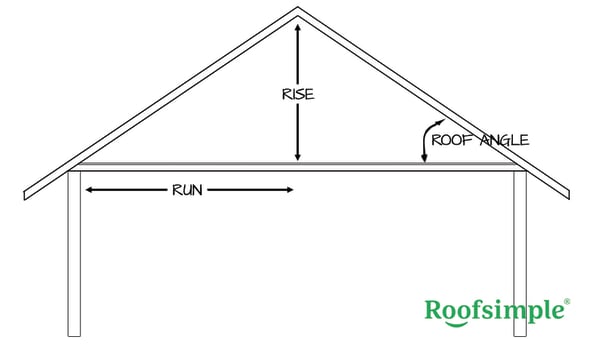
Roof Tiles
Traditionally made from locally available materials, roof tiles are hung from the framework of the roof (or fixed to battens). Roof tiles have been used for thousands of years, with some of the oldest examples dating back to the 3rd millennium BCE. Today, they are most commonly made of clay, concrete, or slate, but can also be made of synthetic materials.
Roof Vents
Intake or exhaust vents used in roof construction to enable the flow of air through a roof and prevent condensation and degradation of roofing materials. Roof vents include: ridge vents, soffit vents, turbine vents, and gable vents.
Vents can be passive, wind driven, or electrically operated.
Run
The run of a roof is the horizontal distance used to measure the rise. Usually measured as the height of the roof per 12 inches of run.
Sales Roofer
Sales roofers are larger companies who do retail roofing or storm chasing. Typically, they do one or the other, but not both. Sales roofers tend to have a large sales force, which means they can schedule your roof replacement quickly.
Self-Sealing Shingles
An asphalt shingle with a self-sealing strip added to boost wind resistance by securing the leading edge of the shingle above it. Generally, it uses factory-applied adhesive that, when heat activated, adheres to the overlying or underlying course of shingles. In colder climates self-sealing cement can be added to ensure proper adhesion.
Service Roofer
A service roofer is one that provides a full range of roofing services. Service roofers often handle installation, insurance claims, roof repairs, inspections for real estate companies.
In addition to the actual work, service roofers provide a higher level of customer service both before and after the job. The focus of a service roofer is on making the customer’s experience as smooth and convenient as possible.
Sheathing
(See: Decking)
Slope
(See: Rise)
Small Businesses Roofer
Small business roofers are those run by one or two people. Staff may include a secretary and one or two crews. They don’t usually offer customer support and their sales volume is lower than larger companies limiting the options and savings they can offer.
Soffit
A soffit is the underside of an exterior or interior architectural feature such as a beam, arch, staircase or cornice. In roofing, it generally refers to the horizontal protective board on the underside of eaves.
Stack Pipe
Stack pipes or “vent stacks” are the pipes leading from the waste pipes to the outside of the building, often going through the roof. These pipes allow the sewer gases to escape to the outside, rather than being released inside the house. The vent pipes also allow oxygen into the waste pipes.
Solar Reflectance Index
The Solar Reflectance Index measures a roof’s ability to reject solar heat (solar reflectance) and release any heat that is absorbed (thermal emissivity).
The higher the SRI number the better.
Squares (roofing square)
A roofing square is equal to 100 square feet of the roof. Therefore a 2,400-square-foot roof would require 24 squares of roofing material to cover that roof. This number is used to calculate both the amount of material needed and to estimate the cost of the project.
The most common type of shingle, called a three-tab or strip shingle, is generally packaged three bundles per square.
Standing Seam
A standing seam is a type of metal roof construction that has concealed fasteners. The material is “seamed” together using a special roof seaming machine that is run vertically up the panel to seal the joints and prevent water intrusion.
Standing seam metal roofs are more durable and weather-tight than exposed fastener metal roofs.
Starter Shingles
Starter shingles (also known as starter strips) are an additional course of asphalt shingles used at the eaves and rake edges of your roof for additional waterproofing.
Storm-Chaser Roofer
Storm chaser roofer refers to roofing companies whose main source of business comes from following storms. After a tornado, hurricane, or hail storm has caused significant damage, they go through the area, knocking on doors, offering to check for roof damage.
This type of roofer focuses on insurance claims. Their goal is to come into a neighborhood that has a high probability of needing their services.
Storm chasers usually get paid with the funds from your insurance claim. But that may not be enough to cover the full cost of a new roof and may still require financing for any remaining balance.
Strip Shingles
(See: Starter Shingles)
Synthetic Slate/Shake
Synthetic slate roofing is a manufactured material designed to look like authentic slate roofing. Faux slate comes in a variety of materials, including plastics, polymers, clay, fiber cement, rubber, steel, and asphalt. It’s available in a wide variety of styles that fit nearly any architectural style.
3-Tab Shingle
Asphalt 3-tab shingles are made of fiberglass layered between asphalt and ceramic-covered granules. What results is a lightweight, waterproof, fire-resistant, and wind-resistant covering for your home. They are the most popular type of roof on the market, with reason.
They’re the most basic and least expensive, entry-level roofing material.
Thermal Emissivity
Thermal emissivity is the ability of a material to release heat that’s been absorbed. In roofing it is associated with energy efficient roofs.
Three-Dimensional Shingles
(See: Architectural Shingles)
Underlayment
Roofing underlayment is the water-resistant or moisture barrier material that is installed on your roof deck and under all other roofing materials. It serves as an added layer of protection from damaged shingles or wind-driven rain.
Valley
The valley of a roof is the channel or trough that is formed where two roof slopes meet. Water is directed to the valleys where it flows off the roof.
Pro tip: Closed valleys refers to a type of valley, where shingles from one or both sides of the roof extend across the valley onto the other slope of the roof. With closed valleys, the flashing is not exposed. There are two types of closed valley: closed-cut and closed-woven valleys.
Closed-Cut Valley
Closed-cut valleys are valleys where shingles from one side of the slope extend several feet onto the adjacent slope, and shingles from the adjacent slope are cut parallel and just short of the center of the valley.
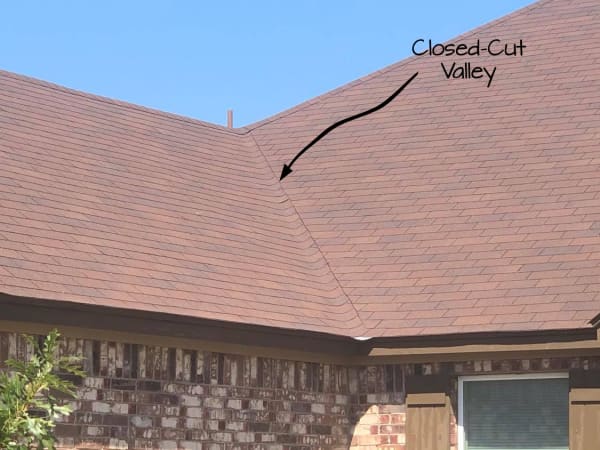
Closed-Woven Valley
With closed-woven valleys, shingles from both sides of the valley extend across to the other slope in an alternating or woven pattern.
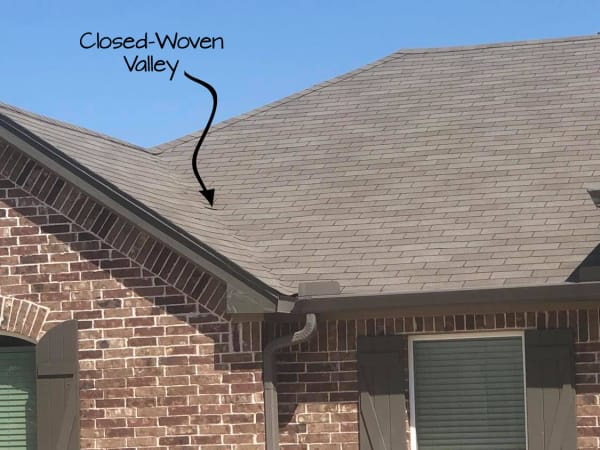
Open Valley
With an open valley, roofing shingles are installed and then cut and sealed where they overlap the metal flashing. The flashing remains visible but is sometimes painted or coated to match the shingles.

Vents
**(**See “Roof Vents”)
Vent Pipe
**(**See “Stack Pipe”)
Vent Sleeve (Vent Flashing)
Vent flashing is a cylindrical piece of flashing that fits right around the vent pipe. Shingles can then be installed over the and around the base or boot. The height of the boot prevents water from flowing under the vent.
Also called “boot flashing”
Wood Shakes
Wood shakes are wooden shingles traditionally made by hand splitting cedar. The process of splitting the cedar into shakes results in a rougher, more rustic finish than wood shingles. Wood shakes are unique in size and shape, which adds a more random pattern and traditional appearance.
Modern shakes are manufactured with one side smooth and one side rough and are much thicker than wood shingles.
Wood Shingles
Wood shingles usually have a smooth, uniform look. Traditionally made by sawing off individual shingles from one block of wood, modern wood shingles are manufactured by machines. Both sides are smooth and consistent in size, shape and taper.
Summing Up
After studying the parts to a roof and this list of roofing terms, you’ll likely start noticing the different types of roof components everywhere you go — but it’s not just about impressing your friends with what you’ve learned.
Your roof is one of the most important maintenance/replacement projects you will undertake as a homeowner. Be as informed as possible. It matters.
A good service roofer will be more than happy to answer any questions you have or explain any terms you don’t understand. But having a better understanding of industry specific terms can help you make your roofing project experience a positive one.